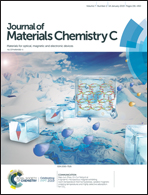Photochromism of aminobenzopyrano-xanthene with different fluorescent behavior in solution and the crystal state†
Abstract
Herein, we report the unique photochromic properties of aminobenzopyrano-xanthene (named cis- and trans-RhRh) in solution and the crystal state. cis- and trans-RhRh show reversible photochromism in DCM, along with the emergence of a new emission band at 550 nm and new absorption bands at ∼497 and ∼527 nm. The initial emission peaks of cis-RhRh and trans-RhRh single crystals appear at 769 nm and 755 nm, respectively, close to the infrared region, which are due to the slip-stacked dimers in the crystal. Upon irradiation with 375 nm UV-light, the emission color of the cis-RhRh single crystal changes from blue to orange-red, accompanied by a decrease in the intensity of the emission peaks at 440 nm and 769 nm. Meanwhile, two broad emission bands at 573 nm and 647 nm emerge, which are attributed to the photo-induced isomerization of RhRh in the crystal state. Interestingly, trans-RhRh is more sensitive to UV light than the cis form, both in solution and the crystal state. This is a rarely reported example of organic molecules achieving intriguing photochromism with fascinating fluorescent behaviors in solution and the crystal state.



 Please wait while we load your content...
Please wait while we load your content...